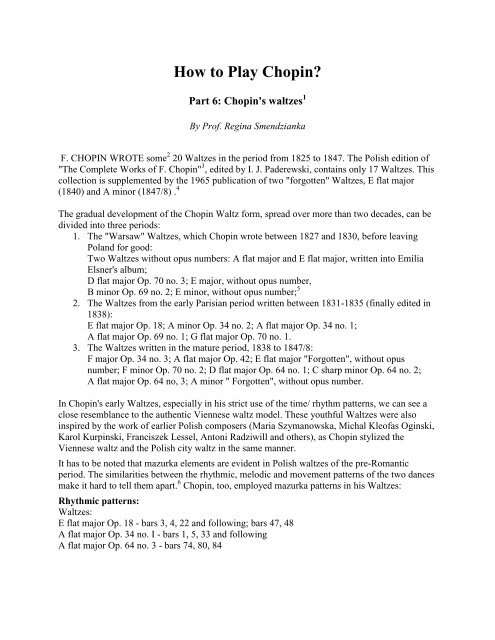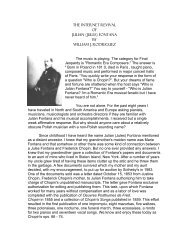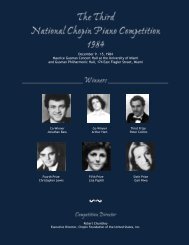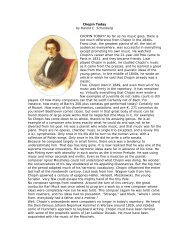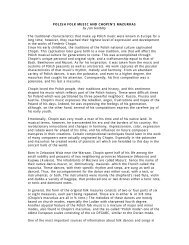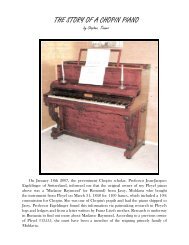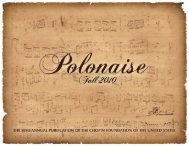Create successful ePaper yourself
Turn your PDF publications into a flip-book with our unique Google optimized e-Paper software.
How to Play Chopin<br />
<strong>Part</strong> 6: <strong>Chopin's</strong> waltzes 1<br />
By Prof. Regina Smendzianka<br />
F. CHOPIN WROTE some 2 20 <strong>Waltzes</strong> in the period from 1825 to 1847. The Polish edition of<br />
"The Complete Works of F. Chopin" 3 , edited by I. J. Paderewski, contains only 17 <strong>Waltzes</strong>. This<br />
collection is supplemented by the 1965 publication of two "forgotten" <strong>Waltzes</strong>, E flat major<br />
(1840) and A minor (1847/8) . 4<br />
The gradual development of the Chopin Waltz form, spread over more than two decades, can be<br />
divided into three periods:<br />
1. The "Warsaw" <strong>Waltzes</strong>, which Chopin wrote between 1827 and 1830, before leaving<br />
Poland for good:<br />
Two <strong>Waltzes</strong> without opus numbers: A flat major and E flat major, written into Emilia<br />
Elsner's album;<br />
D flat major Op. 70 no. 3; E major, without opus number,<br />
B minor Op. 69 no. 2; E minor, without opus number; 5<br />
2. The <strong>Waltzes</strong> from the early Parisian period written between 1831-1835 (finally edited in<br />
1838):<br />
E flat major Op. 18; A minor Op. 34 no. 2; A flat major Op. 34 no. 1;<br />
A flat major Op. 69 no. 1; G flat major Op. 70 no. 1.<br />
3. The <strong>Waltzes</strong> written in the mature period, 1838 to 1847/8:<br />
F major Op. 34 no. 3; A flat major Op. 42; E flat major "Forgotten", without opus<br />
number; F minor Op. 70 no. 2; D flat major Op. 64 no. 1; C sharp minor Op. 64 no. 2;<br />
A flat major Op. 64 no, 3; A minor " Forgotten", without opus number.<br />
In <strong>Chopin's</strong> early <strong>Waltzes</strong>, especially in his strict use of the time/ rhythm patterns, we can see a<br />
close resemblance to the authentic Viennese waltz model. These youthful <strong>Waltzes</strong> were also<br />
inspired by the work of earlier Polish composers (Maria Szymanowska, Michal Kleofas Oginski,<br />
Karol Kurpinski, Franciszek Lessel, Antoni Radziwill and others), as Chopin stylized the<br />
Viennese waltz and the Polish city waltz in the same manner.<br />
It has to be noted that mazurka elements are evident in Polish waltzes of the pre-Romantic<br />
period. The similarities between the rhythmic, melodic and movement patterns of the two dances<br />
make it hard to tell them apart. 6 Chopin, too, employed mazurka patterns in his <strong>Waltzes</strong>:<br />
Rhythmic patterns:<br />
<strong>Waltzes</strong>:<br />
E flat major Op. 18 - bars 3, 4, 22 and following; bars 47, 48<br />
A flat major Op. 34 no. I - bars 1, 5, 33 and following<br />
A flat major Op. 64 no. 3 - bars 74, 80, 84
Melodic/movement patterns:<br />
Swinging (like a pendulum) movement:<br />
Waltz A flat major Op. 69 no. I - bars 33, 34<br />
Anchor-like movement:<br />
Waltz E flat major Op. 18 - bar 5 and following<br />
Revolving (like windmill blades)<br />
Waltz F major Op. 34 no. 3 - bar 17 and following<br />
D flat major Op. 64 no. I - bar I and following<br />
The Chopin Waltz form, just like that of the earlier composers, is confined within the reprise<br />
pattern. 7 However, <strong>Chopin's</strong> talent is by far greater than that of his Polish predecessors, and so is<br />
his creative imagination and sophisticated technique. Thanks to these qualities he gave the Waltz<br />
an artistic status; his Waltz is a dance poem freed from its former utility function. Chopin also<br />
had the edge over his contemporaries. Writing his <strong>Waltzes</strong>, he took advantage of the greater<br />
possibilities offered by the then-modern instrument to add a virtuoso element to this dance form,<br />
including octaves leaps, glissandos, passages and figurations based on the wide range of piano<br />
registers. In this way he gave this dance the qualities typical of the brillante style. Furthermore,<br />
Chopin used a whole range of emotions reflecting his personal feelings thanks to which his<br />
<strong>Waltzes</strong> have their own unique character. The richness of expression and the variety of moods<br />
reflect the vividness of the composer's imagination. At the same time, the lyrical quality of the<br />
Waltz, along with a strong emphasis of the cantilena element, offers an insight into his<br />
intellectual abilities.<br />
As regards the texture of <strong>Chopin's</strong> Waltes, in these generally homophonic pieces we can find<br />
examples of polyphony: (A flat major Op. 42; D flat major Op. 70 no. 3 (bars 1- 16);<br />
A flat major Op. 64 no. 3 - Trio). However, typical of this polyphony is that it smoothly changes<br />
to the homophonic-type texture (a characteristic trait of <strong>Chopin's</strong> polyphony.<br />
<strong>Chopin's</strong> <strong>Waltzes</strong> provide interesting instances of polymetrics: F major Op. 34 no. 3 (bars 17-<br />
48); D flat major Op. 64 no. I - bars 52, 53; C sharp minor Op. 64 no. 2 - bars 92, 93; A flat<br />
major Op. 42 (bars 9-40).<br />
The Chopin Waltz harmonics' richness comes from changes in the keys used in individual<br />
periods (themes), the deceptive cadences, chromatic scale and exquisite modulations. This<br />
develops together with <strong>Chopin's</strong> composing technique used for writing other pieces. Special<br />
notice should be given to the remarkable "mobility" of the modulation in the last Waltz (A flat<br />
major Op. 64 no. 3). The harmony of this Waltz displays some qualities of the "last" Chopin.<br />
This "bird's eye view" of <strong>Chopin's</strong> entire Waltz cycle, while far from presenting a complete<br />
picture of the form and content of these pieces, can give us some idea about the range of the<br />
interpretive means which are required for playing these miniature pieces. It is important that the<br />
interpreter of <strong>Chopin's</strong> <strong>Waltzes</strong> not only clearly presents the character and mood of each piece,<br />
but also employs distinctly different means of expression, depending on when (in which period)<br />
they were written. The means used for bringing out the sentimental style of the youthful <strong>Waltzes</strong><br />
cannot be employed for playing the mature <strong>Waltzes</strong>. Similarly, the tools of interpreting <strong>Chopin's</strong><br />
late and last <strong>Waltzes</strong>, when used to perform the simple and straightforward pieces from his early<br />
period, may dangerously distort them into musical caricatures.<br />
It might also seem that a practical knowledge of the waltz and the ability to "perform" it in the<br />
ballroom is the simplest way to understand and feel its unique atmosphere, charm, elegance, and<br />
conventional distance. A word of caution, however: the above qualities of the waltz are, in the
case of Chopin, interspersed with fragments of sincere lyrical expression, sometimes with bitter<br />
reflection, while at other points, with unrestrained joy and gaiety. The kaleidoscopic pattern of<br />
moods occurring in individual periods (themes) of <strong>Chopin's</strong> <strong>Waltzes</strong> and the contrasting climate<br />
and nature of the interwoven fragments require that the interpreter has enough ability, mental<br />
flexibility and iron intellectual discipline to cope with these problems and still to create the<br />
impression of light social entertainment.<br />
English translation: Jerzy Ossowski<br />
________________________________<br />
1 The waltz (Walzer), initially a folk dance originated in southern Germany (1750), was danced<br />
in slow 3/4 and 3/8 time by couples in clogs or hobnailed boots on the lawn in front of the village<br />
inn or in the town square. In the early 1911 century the waltz moved to cities and became<br />
popular among Vienna's bourgeoisie. The ballroom waltz was faster with long, smooth steps and<br />
more flexible figures. This was possible thanks to the light shoes and dress worn by dancers, as<br />
well as to the waxed floor. The waltz has only one accent, on "one," the remaining beats in the<br />
bar are light and equal in length.<br />
2 The term "some" results from the fact that <strong>Chopin's</strong> first <strong>Waltzes</strong>, composed in 1825 and 1828,<br />
have been lost.<br />
3 Dziela wszystkie F Chopina [The Complete Works of F. Chopin]. Instytut F. Chopina, Polskie<br />
Wydawnictwo Muzyczne. Cracow 1949.<br />
4 Dwa zopomnione utwory Chopina [Two Forgotten Pieces by Chopin], edited by Antoni<br />
Koszewski. Polskie Wyclawnictwo Muzyczne. Cracow 1965.,<br />
5 in publications the <strong>Waltzes</strong> without opus numbers are marked " op. post."<br />
6 Koszewski, A., Melodyka Walcow Chopina, (w): Studio Muzykologiczne (in Polish) [The<br />
Melodic Structure in Chopin <strong>Waltzes</strong> (in): Musicological Studies]. Cracow 1953, volume 2.<br />
7 In Chopin, the A-B-A reprise form is often preceded by an Introduction and finished, especially<br />
in his later <strong>Waltzes</strong>, with spectacular Coda. The clearly separated middle part (Trio) is in contrast<br />
to the outer parts as regards mood and texture.<br />
This is the last article in a series of six highly acclaimed works in which the author deals<br />
with the difficult matter of interpretation of Chopin music. All of them are published on<br />
the Chopin Foundation's web site at www.chopin.org


